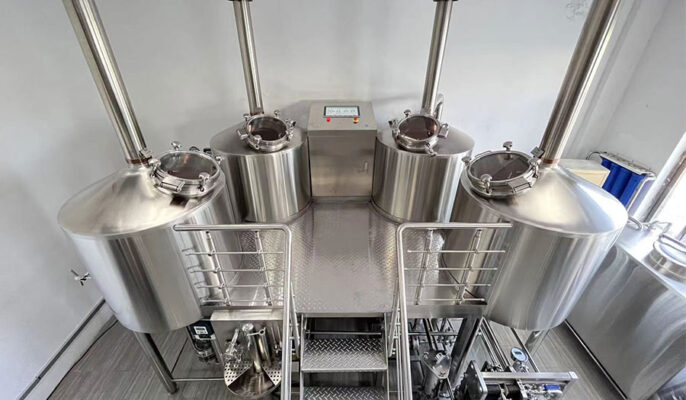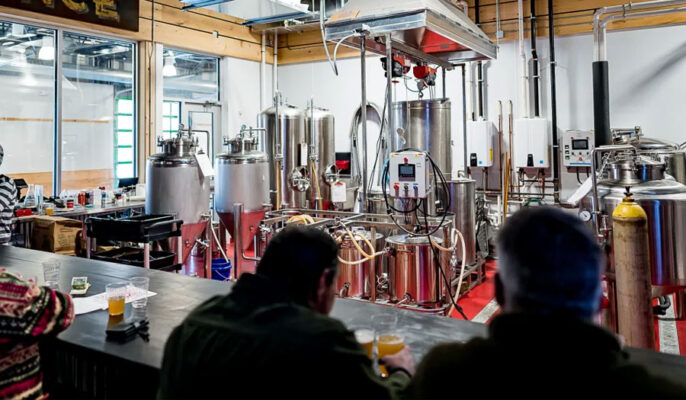Lorsque vous décidez d'ouvrir une brasserie artisanale, il est important de choisir un emplacement où vous aurez des clients réguliers et où vous attirerez de nouveaux clients, ce qui est essentiel pour le succès de votre brasserie artisanale. Ces dernières années, avec l'évolution de la consommation, le secteur de la bière artisanale a émergé. De plus en plus de gens aiment boire de la bière artisanale et, parallèlement, de plus en plus de gens envisagent de se lancer dans ce secteur et d'ouvrir leur propre brasserie artisanale. Le groupe Micet est un fabricant professionnel d'équipements pour la bière. Ce guide explique comment choisir un emplacement. Voyons maintenant ce qu'il en est.
Apprendre les lois et réglementations locales
Lorsque vous envisagez d'ouvrir une brasserie artisanale, la première chose que vous devez apprendre et comprendre est la législation en vigueur dans votre État. Chaque État dispose de son propre ensemble de lois et de règlements qui déterminent où les brasseries artisanales peuvent ou ne peuvent pas ouvrir. Les lois de l'État peuvent vous aider à comprendre où les brasseries artisanales en ville sont autorisées et, surtout, où les brasseries sont interdites. Bien que les lois varient d'un État à l'autre, la plupart de ces zones réglementées sont situées à proximité des écoles et des églises. Vous pouvez obtenir ces informations sur le site web de votre autorité locale, car elles sont généralement répertoriées.

Comprendre les données relatives aux clients cibles
Il est essentiel de comprendre votre clientèle cible. Essayez-vous de répondre aux besoins d'une clientèle plus jeune et plus à la mode, ou visez-vous des consommateurs plus âgés et plus aisés ? Tenez d'abord compte de l'âge et du revenu. En identifiant votre public cible, vous pouvez choisir une zone entourée de clients potentiels qualifiés.
En outre, il est essentiel d'évaluer les intérêts et les goûts de votre public. S'agit-il d'un buveur de bière aventureux, désireux d'essayer de nouveaux styles ? Ou préfèrent-ils la bière traditionnelle ? En vous renseignant sur la scène locale de la bière artisanale, vous pourrez trouver des lieux qui correspondent aux préférences de vos clients potentiels.
Quel que soit votre public, il est également important de tenir compte de facteurs tels que le stationnement et l'accessibilité. La dernière chose que vous souhaitez, c'est que vos clients ne puissent pas trouver de place de parking à proximité, ou que la place de parking soit si éloignée qu'il soit difficile pour les personnes handicapées ou à mobilité réduite de vous trouver.
En vous plaçant dans une zone piétonne, vous améliorerez votre accessibilité et votre visibilité. Les quartiers piétonniers présentent de nombreux avantages, notamment
- Sécurité
- Une meilleure culture
- Une économie plus forte
- Plus durable
Facteurs à prendre en compte lors du choix d'un brasserie artisanale emplacement
Situation géographique
Pour les nouvelles brasseries, l'emplacement est important. Nous devons tenir compte de la relation entre l'emplacement de l'usine et l'emplacement des ventes. Plus la distance est courte, meilleur est le transport. Il convient de prêter attention à l'environnement du site de l'usine, par exemple à la présence d'usines de traitement du fumier, de vergers, d'usines de produits toxiques, etc. Les brasseries doivent rester à l'écart de ces installations, faute de quoi la qualité du brassage s'en ressentira. Les brasseries doivent rester à l'écart de ces installations, faute de quoi la qualité du brassage s'en ressentira.
Le choix d'un emplacement proche d'une route principale est essentiel pour le succès d'une brasserie. Non seulement il augmente la visibilité, mais il permet également aux clients de vous trouver facilement. En outre, cela simplifie le processus de livraison des produits aux bars, restaurants et magasins locaux. En bref, la proximité des grands axes routiers est bénéfique à la fois pour vous et pour vos clients.
Proche des matières premières
Lorsque vous choisissez le lieu d'implantation de votre brasserie artisanale, tenez compte de la distance qui vous sépare des matières premières dont vous avez besoin. Les agriculteurs locaux peuvent-ils vous fournir du houblon, de l'orge et d'autres ingrédients essentiels ? L'approvisionnement en ingrédients permet d'économiser sur les frais de transport et de mettre en valeur les saveurs uniques de la région. La distance par rapport aux fournisseurs d'emballage et d'expédition est un autre facteur à prendre en compte. La proximité de ces ressources peut vous aider à économiser sur les frais d'expédition et à garantir l'emballage et l'expédition de vos produits.

Estimation des coûts des services publics
Coût de l'énergie
L'exploitation d'une brasserie artisanale nécessite une grande quantité d'énergie pour maintenir l'équipement au frais pendant le processus de brassage, de l'empâtage à la fermentation et à l'embouteillage. Si vous envisagez d'acheter une brasserie appartenant à quelqu'un d'autre, vous pouvez obtenir le rapport de consommation de l'année dernière auprès de la société de services publics et estimer votre consommation d'énergie pour cette année. Si vous ouvrez une nouvelle brasserie artisanale, obtenez des estimations et des tarifs afin de pouvoir travailler avec la brasserie pour estimer les coûts énergétiques.
Source d'eau
Le brassage de la bière est indissociable de l'eau. Qu'il s'agisse de l'eau de brassage ou d'autres eaux dans l'usine, elle est très coûteuse. Nous savons que l'eau de brassage doit au moins répondre aux normes en matière d'eau potable, mais nous n'utilisons généralement pas d'eau purifiée ou d'eau distillée pour brasser de la bière, car la teneur en ions de l'eau purifiée ou de l'eau distillée est trop faible. Selon certains experts de la bière artisanale, "la bière brassée n'a pas d'os". Dans le cadre du processus de sélection du site de la brasserie, nous devons donc nous demander quel type de source d'eau je vais utiliser pour le brassage et quelle est la qualité de l'eau à cet endroit. La qualité de l'eau détermine les besoins en équipements de traitement de l'eau après la construction de l'usine, et la qualité de l'eau a un impact significatif sur le goût de la bière. Il est donc possible d'effectuer des analyses de la qualité de l'eau avant de déterminer le site de l'usine et de prendre des décisions sur la base du rapport d'analyse de la qualité de l'eau.
Comprendre les besoins en espace de votre brasserie artisanale
Lorsqu'il s'agit de choisir l'emplacement d'une brasserie artisanale, le facteur le plus important à prendre en compte est l'espace. En règle générale, plus le bâtiment est grand, plus le prix est élevé. Il faut donc vérifier l'espace dont on a besoin. Les brasseries artisanales produisent moins de 100 000 gallons de bière artisanale par an, mais même les équipements de brassage à petite échelle nécessitent beaucoup d'espace. La meilleure façon de procéder est d'effectuer une analyse du seuil de rentabilité. Quelle quantité de bière devez-vous produire/vendre pour atteindre le seuil de rentabilité ? Une fois l'analyse du seuil de rentabilité terminée, les besoins en termes de capacité et de production peuvent être pris en compte.
Bien entendu, vous pouvez également consulter le équipement pour la bière Les ingénieurs peuvent vous aider à déterminer si vous avez besoin d'un équipement pour la bière de 500 litres ou de 1000 litres. Les ingénieurs peuvent vous aider à déterminer si vous avez besoin d'un équipement de brasserie de 500 litres ou de 1000 litres, ainsi que le nombre et la capacité des cuves de fermentation dont vous avez besoin. Il y a un autre élément important à prendre en compte lors de l'achat d'un équipement de brasserie : la hauteur du bâtiment. Les cuves de fermentation ont une hauteur comprise entre 5 et 9 pieds, et l'équipement de brasserie varie en fonction de la hauteur du bâtiment. Si une brasserie a une hauteur de bâtiment limitée, elle aura besoin d'un équipement plus large pour compenser, ce qui signifie plus de surface.
Concevez votre brasserie artisanale
Lorsque vous commencez à chercher l'installation qui vous convient, vous devez déterminer si le bâtiment est propice au brassage de la bière. Maintenant que vous avez une idée approximative du nombre de mètres carrés dont vous aurez besoin, vous pouvez créer un plan simple de votre bâtiment et déterminer s'il convient au brassage de la bière. C'est aussi le moment de faire appel à un ingénieur en brasserie, car les dessins en CAO sont plus professionnels que les dessins sur une serviette de table. Le facteur déterminant de la croissance rapide du secteur de la bière artisanale est la premiumisation. Le terme "premium" signifie que les consommateurs sont prêts à payer un prix plus élevé pour des produits qu'ils considèrent comme uniques. Les brasseries artisanales qui réussissent ne vendent pas de la bonne bière, elles vendent des histoires. Lorsque vous serez prêt à faire votre choix final, recherchez un équipement de brasserie artisanale qui soit à l'image de votre marque.




